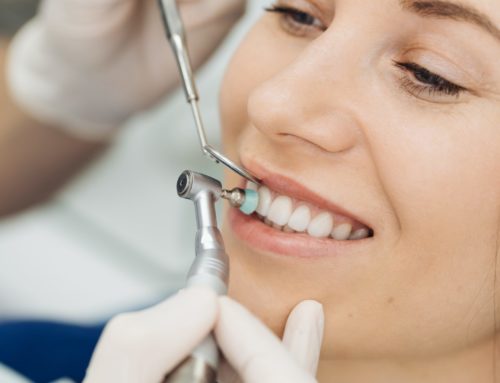Easily Clean Between Teeth with Water Flossers
Developing a good oral health care routine includes regularly cleaning in between the teeth, but there are several different ways to do this. Patients can choose from traditional dental floss, interdental brushes and picks, and water flosser devices to reach places in between the teeth that normal toothbrushes just can’t reach. Water flossers are very popular, but what kinds of advantages do they offer over other methods?
Taking care of your teeth at home requires a few essential products in order to do it right. You need a toothbrush with soft bristles and a comfortable handle, a good quality fluoride toothpaste that leaves your breath fresh, and some way to clean in between the teeth where your toothbrush can’t reach. In most cases, this is done by dental floss, but that’s not the only product available that can do the job. In fact, there are many different interdental cleaning methods to choose from, including dental floss, interdental picks, and water flossers, to name a few.
While regular dental floss is by far the most popular and common method of cleaning in between the teeth, there may be specific reasons why a different method may be recommended by your dentist or hygienist. Personal preference also plays a determining factor in what type of interdental cleaning products you may choose to use to help keep your teeth healthy and strong. However, before we get into the differences between the various interdental cleaning products, it’s important to clearly understand exactly why flossing and cleaning between the teeth is so essential to our dental health.
Why is Flossing So Important?
Keeping our teeth clean starts with diligent tooth brushing habits, but the fact is that toothbrush bristles are simply not capable of reaching all the different spaces in our mouths where bacteria and food particles can accumulate. You could brush for an hour and still leave behind stubborn particles in the nooks and crannies in your gums and between your teeth. To get a full-mouth clean, you’ve got to employ other methods to get into those hard-to-reach spots. By taking a more thorough approach to at-home oral care, including interdental cleaning, you will realize many health benefits.
Breath Stays Fresher
One of the first things people notice when they start to be more frequent in flossing and cleaning in between their teeth is a reduction in the frequency and severity of foul breath. Bad breath is caused by bacteria in the mouth, which gives off a nasty odour. When bacteria is allowed to remain in the deep pockets of the gums and in between the teeth, bad breath comes back quickly even after brushing. Cleaning out those hidden bacteria pockets leaves your breath fresher for much longer periods of time.
Lower Risk of Developing Cavities
Another effect of allowing bacteria to remain in contact with the teeth for long periods of time is an increased likelihood of forming cavities. You see, bacteria by-products create an acidic environment in the mouth which gradually erodes the hard outer enamel of the teeth. Over time, this will result in cavities in the teeth. If left unchecked these cavities can grow rapidly and cause extensive tooth decay, possibly resulting in infections or even tooth loss. Flossing regularly helps keep acidity in the mouth down by removing harmful bacterial deposits and helping tooth enamel remain strong.
Prevention of Gum Disease
Tooth decay isn’t the only problem caused by bacterial deposits in the gums and between teeth. Gum disease is an affliction that affects many Canadians, and can be prevented. Gum disease, also known as periodontitis, is caused by bacterial infections in the gums. If left untreated, gum disease can advance quickly and cause many other severe health issues. Gum disease is one of the leading causes of tooth loss in adults, so it’s critical to take good care of your gums to avoid these types of problems. Interdental cleaning is one of the most effective preventive measures you can take to stave off gum disease and keep your mouth healthy.
With all these notable health benefits, it’s clear that flossing is something we should all be doing on a daily basis. That said, it’s common for some people to perhaps find flossing using regular dental floss to be a little uncomfortable or awkward. Fortunately, there are other alternative methods that can be used to perform the same task and get rid of those nasty bacteria in between teeth and in gum pockets.
Exploring Different Interdental Cleaning Products
Dental Floss – The most common way to clean in between the teeth is the string-type dental floss we are all familiar with. There are multiple varieties of dental floss to choose from, including waxed floss for easier sliding, scented/flavoured flosses such as mint, and satin-feel floss for a softer texture. Using a length of floss wrapped around two fingers, the floss is gently worked in between each tooth and down into the gum areas to loosen and remove plaque deposits and leftover food particles.
Dental Tape – Similar to dental floss in how it works, dental tape comes in a wider band format which makes it easier to clean in between teeth where there are larger gaps and more room for bacteria to accumulate. Dental tape is used just like dental floss, and is worked in between the teeth and down to the gums to remove built-up plaque and food remnants. For people with tighter spacing between their teeth, dental tape might not be as easy to work with as thinner dental floss.
Interdental Picks – An alternative to thin, flexible floss, interdental picks use a long, skinny plastic or rubber tip to probe in between the teeth and into the gum pockets to remove plaque and bacterial deposits. Some people prefer the way interdental picks feel in their mouth and in their hands, and find them easier to manipulate. However, it’s important to note that interdental picks may not be tiny or flexible enough to reach all the narrow gaps that dental floss can, so you may need to use both to get a complete clean.
Interdental Brushes – Interdental brushes look similar to interdental picks, only they have small soft bristles along their length to act as a combination pick-and-brush to scrub and clean in between the teeth and in the gums. This has the added benefit of providing better cleaning action than a pick, but also adds to the width of the device and can make it less effective at reaching very small spots. If using an interdental brush, it’s recommended to still floss as well to get a more complete clean.
Water Flossers – Unlike the other interdental cleaning methods which use physical contact, water flossers are devices that utilize streams of focused water to loosen and wash away plaque and food particles. Let’s explore how a water flosser works in more detail.
How Does a Water Flosser Work?
A water flosser is similar in resemblance to some of the tools used in your dentist’s office to help clean and wash your teeth during a professional checkup. The device itself consists of a base where the electronic components, pump, and reservoir are located. The handheld water flosser wand is attached to the base with a thin hose, and has interchangeable tips that can be used to create water streams of different sizes and shapes. In addition, the same water flosser can be used by multiple people in the same household, as you can get multiple copies of the interchangeable tips so each user can have their own set.
To use the water flosser, you simply fill the reservoir with fresh water, connect the desired water flosser tip to the handheld wand, place the tip into your mouth, and turn the unit on. The water flosser will then begin pumping the water through the hose, into the wand, and out through the tip. Most water flossers have adjustable pressure settings so you can increase or decrease the force of the water to suit your comfort level. Position your head over your sink as you use the device and allow the water to flow out of your mouth and into the sink basin.
To clean using a water flosser, simply maneuver the wand around your mouth, allowing the pulsing water jets to contact your teeth, penetrate the gaps in between your teeth, and rinse down into the gums. The gentle yet firm action of the water pulses will loosen stuck-on plaque and bacteria accumulations, and feels very pleasant on the gums. The sensation of the water massaging the gums is one of the bonuses of water flossers that many people quite enjoy.
For added anti-bacterial cleaning action, you can also add a small amount of mouthwash to the reservoir of water. This mouthwash-water mixture will disinfect your mouth as it cleans in between your teeth and around your gums, leaving your mouth feeling incredibly fresh and clean. A good rule of thumb to ensure proper operation of the unit is 2 parts water to 1 part mouthwash. Just be sure to keep the ratio of water to mouthwash no stronger than 1:1 at the very most. Never add substances such as salt or essential oils to the water, as these are not compatible with the components used in water flossers and can damage them beyond repair.
What Are the Advantages of Water Flossers?
There are several advantages of water flossers that make them an appealing choice for many people. First, the gentle pulsing action of the water jets are quite comfortable, and the device itself is very easy to use. It also has the advantage of being a one-time purchase, as all it requires is a fresh supply of water whenever you want to use it. Products like interdental picks and brushes may be one-time-use disposable items, and products like dental tape and dental floss must be replaced when they run out.
The ability to add antibacterial mouthwash into the water supply of a water flosser is another bonus, as it essentially combines flossing and oral rinsing into one step, saving you time in your daily oral care routine. For patients who are undergoing treatment for gum disease or early-onset periodontitis, this antibacterial action is most valuable, and the gentle massaging effect of the water pulses soothes sore gums for added relief.
Furthermore, patients who have received dental implants or dental bridges to replace lost or missing teeth can also benefit from the functions of a water flosser. According to a 2019 study conducted on the effectiveness of various interdental cleaning types, it was shown that water flossers performed better at cleaning around dental implants and other types of dental prostheses than alternative interdental cleaning methods.
Is a Water Flosser Right For You?
If a water flosser sounds intriguing, but you’re still not sure if it’s right for you, the best thing to do is to arrange for your next dental appointment and have an in-depth discussion with your dentist and hygienist. Taking into consideration your current state of dental health, and your past dental history, they will be able to provide you with the guidance and advice you need to make the best choice for interdental cleaning. Get in touch with the team here at Georgian Dental today to book your appointment and have your questions answered. We look forward to seeing you!
Appointment Request
If you’re interested in any of our procedures, and would like to meet with one of our dentists to discuss options, costs and get additional information, complete this short form and we’ll give you a call to arrange for a no-obligation appointment at our Barrie clinic.









